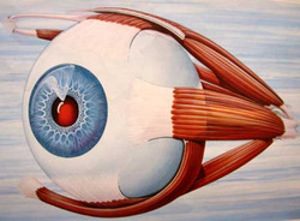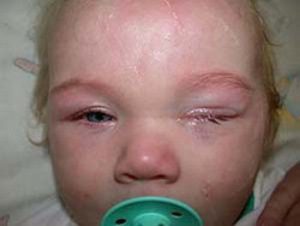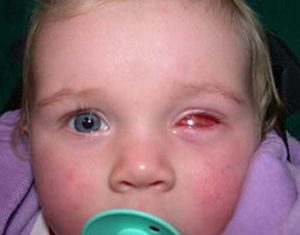Enucleation
Child

Removal of an eye or Enucleation is still the commonest form of treatment in both Unilateral and Bilateral Sporadic RB. The reasons for performing enucleation of an eye in RB include:
- The tumour inside your child’s eye is too large or extensive to safely control with eye saving treatments, such as chemotherapy or radiotherapy.
- There is no hope of preserving vision in this eye.
- Leaving the eye in place may threaten the life of your child.

Anatomy of the eye and orbit
The Operation
Enucleation is always performed whilst your child is asleep under a general anaesthetic and they will need to stay in hospital for a couple of days after the operation.
The eyelids are not cut or altered during the operation. There are six muscles and a large nerve (optic nerve) attached to the eye. These all need to be divided before the eye can be removed. An orbital implant, approximately two centimetres in diameter, is placed into the space that remains after the eye has been removed. The most commonly used implant in children is made from an artificial coral-like substance known as hydroxyapatite. Four of the muscles are reattached to this implant so that the new artificial eye will have the potential for movement. The conjunctiva (the thin transparent layer of tissue over the white of a healthy eye) is then closed over the implant. A clear curved plastic disc, called a conformer, is placed in the space between the eyelids and the conjunctiva overlying the implant (socket). A firm bandage is then placed over the area and will remain in place for one and a half to two days after the operation.

Immediately after operation
Following the Operation
Following the operation you will be able to remain in hospital with your child. There will inevitably be some discomfort and your child may be quite miserable for the first 24 hours. The nursing staff on the ward will make sure that optimum pain relief will keep your child as comfortable as possible.
One and a half to two days after the operation the pad will be removed by your eye doctor and you will be able to take your child home. You will notice that the eyelids will be swollen and perhaps a little bruised, but this will settle rapidly over the next few days. The upper eyelid will remain a little droopy until the artificial eye is fitted.

Immediately after removal of pad
You will notice a pinkish-red colour when the eyelids are opened, but will be relieved to see that the appearance is not at all disturbing or offensive – it looks much like the inside of the mouth.
You will see the clear plastic conformer sitting in place behind the eyelids. The conformer helps to maintain the normal position of the eyelids and prevent shrinkage of the tissues of the socket before the artificial eye is fitted. It does not need to be touched, but occasionally the child may rub it out. If this happens, there is no need to panic. Just collect the conformer, clean it with soapy water and bring it in to your eye doctor in an envelope when you next visit. Your doctor may try to replace the conformer, but there is no urgency and there is no problem if it remains out until this time.
Your child may have mildly blood stained tears for a few days after the operation, but this is not a concern. If you notice a large amount of fresh blood or if the eyelids become hot, red and swollen, contact your eye doctor immediately.
Medications
Your child will need to take antibioptic syrup (eg. Keflex) for two weeks following the operation and you will need to place an antibiotic drop (eg. Chlorsig) in the eye three times per day for the same period of time.

One week following the operation
Pathology Results
One week following the operation you must return to see your eye doctor to discuss the results of the cellular examination or pathology of the enucleated eye and tumour.
Artificial Eye
Your child’s artificial eye will be made four to six weeks following the operation. Please go to the Artificial Eye page for further information
